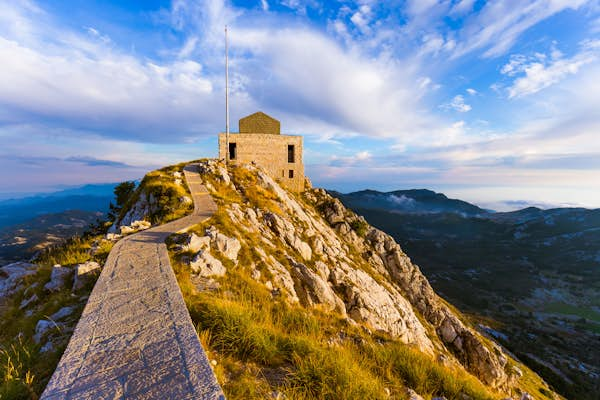
Explore the staggering beauty of Montenegro’s national parks
Montenegro may be famed for the beauty of its Adriatic coastline dotted with stunning beaches and coves, but even more treasures await you inland. Five national parks with distinctly different landscapes preserve the impeccable unspoiled scenery and create a wonderland of outdoor adventures amidst deep river gorges and rugged mountains.
Pack up your beach towel and tear yourself away from the coast – it’s time to immerse yourself in Montenegro’s wild side. Here’s everything you need to know about its national parks.
1. Hike the mountain trails of Lovcen National Park
If you visit just one Montenegrin national park, make it this one. Looming above the Bay of Kotor, Lovcen is the black mountain that gave Montenegro its name and this national park sprawls over its slopes. For centuries, this karst massif was the very crucible of Montenegrin culture – a rocky redoubt of resistance to the Ottomans, populated by fearsome warriors, clerics and poets – and it remains the nation’s spiritual hub. The old royal capital, Cetinje, is nestled on its slopes and it makes a perfect base for exploring, though the park also can be easily accessed from the coastal hotspots of Kotor and Budva.
Allow time to investigate Cetinje’s palaces and museums before heading into the national park proper. There’s a visitor center in the hamlet of Ivanova Korita where you can gather information on Lovcen’s numerous hiking and mountain-biking tracks before you continue to the park’s most famous feature, the striking Njegoš Mausoleum, containing the tomb of the philosopher-poet Petar II Petrović-Njegoš, sitting at the top of its second-highest peak at 1657m (5436ft). Gargantuan statues by acclaimed Yugoslav-era sculptor Ivan Mestrovic compete for attention with the extraordinary views, as the craggy landscape dissolves into the distance.
Planning tip: As you loop back to your start point, be sure to stop for a snack at the village of Njegusi. As well as being the ancestral home of Montenegro’s Petrovic dynasty, this small settlement is famed throughout the region for its prosciutto, cheese and honey.

2. Spot myriad bird species in Lake Skadar National Park
Split between Montenegro and Albania, Lake Skadar is the largest lake in the Balkans and one of the most important habitats for wetland birds in all of Europe. The entire Montenegrin side of the lake has been protected as a national park since 1983, and birdwatchers come from around the world to spot the 270 species that shelter here, including the endangered Dalmatian pelican and a globally significant population of pygmy cormorants.
Boats and kayaks can be rented from the lake’s main settlement, Virpazar, and from the national park visitor center across the causeway near Vranjina, for exploring at surface level. Birdwatching expeditions can be combined with visits to the cluster of tiny islands on the lake, which are home to medieval monasteries. Also here is the Ottoman-built prison fortress, Grmozur, once known as the Montenegrin Alcatraz.
Alternatively, paddle up the sinuous Crnojevic River to the historic village of Rijeka Crnojevica, or hire a bike to explore the tiny wine-making villages and ruined fortresses hidden in the lush hinterland around the lake. It’s also fun to take a plunge into the river from the terrace of the floating restaurant in the village of Dodosi or join the local daredevils diving off the bridge.
Planning tip: Remote Murici, on the lake’s southwestern shore, is one of Montenegro’s best beaches. It’s a 40-minute drive to Murici from Virpazar and there’s a campground for overnight stays.

3. Hike the trails of Durmitor National Park
The jewel in the crown of Montenegro’s national parks is the mountainous Durmitor in the country’s untamed north. This highly dramatic reserve boasts around 50 peaks higher than 2000m (6562ft) and 18 glacial lakes known as gorske oci, meaning “mountain eyes.” The park also embraces the Tara Canyon, a cleft in the limestone cut by the Tara River over many millennia. The gorge’s forested walls reach 1300m (4265ft) at their highest point.
Rafting is by far the best way to see the canyon, and numerous operators offer trips along the last 18km (11 miles) of the gorge, where you will find most of the rapids. However, you’ll have to book the classic two-day overnight journey to visit the deepest part of the canyon.
In winter, Durmitor is a major ski destination, offering the country’s most reliable snow cover and two ski centers. Javorovaca is best for beginners while Savin Kuk caters to more advanced skiers. In summer, the focus shifts to hiking and mountaineering. Around 150km (93 miles) of marked trails meander through the mountains, ranging from the easy stroll around the picturesque Black Lake to major alpine expeditions where a local guide is strongly recommended.
Planning tip: Just south of the national park, near Šavnik, the remarkable Nevidio Canyon is a favorite spot for canyoning (canyoneering to Americans). Cut by the Komarnica River, the gorge is only meters wide at points, and guided expeditions only run during the dry months of July and August.

4. Hike the forests of Biogradska Gora National Park
Located within the Bjelasica mountain range, Biogradska Gora National Park protects an exceptionally lovely area of virgin forest. From the park entrance, you can take a 3.5km (2.2-mile) trip on a tourist train to the vividly green waters of tree-lined Lake Biograd. Here you will find the main park infrastructure, including a campsite, cabins, rowboat and kayak rental and a restaurant serving traditional Montenegrin mountain fare.
Take an easy 3.4km (2.1-mile) amble around the lake, then inquire at the visitor center about more challenging hiking and mountain-biking tracks through the surrounding mountains, including overnight trips through remote sections of the reserve. There are also glacial lakes to explore and several peaks above 2000m (6561ft), including 2139m (7018ft) Crna Glava, the “Black Head.”
Planning tip: In summer, it is possible to take multi-day hikes through Biogradska Gora National Park staying overnight in katuns, the traditional wooden huts used by the region’s semi-nomadic shepherds; contact the park visitor center for information.

5. Trek the wilds of Prokletije National Park
For true wilderness, you can’t beat Montenegro’s newest national park, dedicated in 2009 to protect a 161-sq-km (62-sq-mile) expanse of the Prokletije Mountains bordering Albania and Kosovo. The southernmost and highest section of the Dinaric Alps is surely one of Europe’s least-explored corners. Prokletije translates to “accursed,” which says all you need to know about the treacherous and unforgiving nature of the terrain.
If you want to push your limits in extraordinarily beautiful, off-the-beaten-track wilderness, this is the place to come. But despite the menacing name, a visit to Prokletije does not have to be a major expedition. Start at the gateway town of Gusinje with a visit to the 17th-century Vizier’s Mosque and then take a half-hour walk to the beautiful Ali Pasha Springs, which bubble up from the karst rocks at the foot of the mountains.
Planning tip: On your way into Prokletije National Park, stop at the park visitor center, where you can gather information on more advanced hiking and climbing routes and make connections with local guides.
You May Also Like

Discover The Power Of Hypochlorous Acid, The Beauty Must-Have For Summer And Beyond
May 17, 2021
13 Most Heroic Soccer Players of All Time
September 20, 2022

